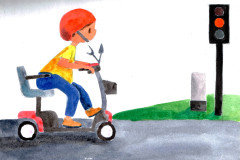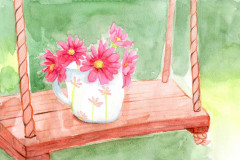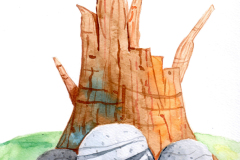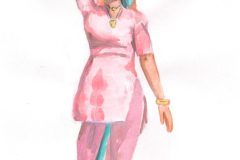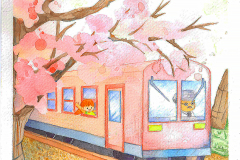Introduction
Urban sketching offers a unique way to see and record cities around you. It involves drawing scenes right where they happen. This way, your sketches tell stories about places and moments in the city. You learn to observe details others might miss and capture life as it unfolds. Urban sketching helps you create real, lively art that shows the city’s true spirit.
This article will guide you through techniques to capture the building shapes, the street scenes, and the busy city atmosphere. You will learn how to choose the right tools, ways to watch the city around you, and how to put what you see on paper with simple steps. Whether you are a beginner or want to improve, these tips will help you sketch the city with confidence.
Getting Started with Urban Sketching
Urban sketching is about capturing real-life city scenes in the moment. It’s a loose, spontaneous practice that anyone can try—not just artists or professionals. You don’t need perfect technique to begin; it’s more about observing and recording what you see around you. For some, it might be a way to relax; for others, a way to understand their surroundings better.
To begin, keep things simple. Find a spot that interests you—a street corner, a park bench, a café window. Just start with quick lines or shapes. Don’t worry about details or mistakes. Try to capture the feeling or mood instead of a perfect likeness. If you hesitate because you think your work isn’t good enough, well, that’s normal. Just sketch anyway.
Choosing your sketchbook and pens
Picking the right materials makes a difference, but there’s no single rule. A smaller sketchbook, around 5×7 inches, fits easily in a bag or pocket, so it’s handy for spontaneous sketches. Larger formats offer more space but can feel cumbersome outdoors.
For pens, many urban sketchers prefer waterproof fine liners or felt tips, often in black. They’re reliable and dry fast—important when drawing outside where you might be in a rush. Some like to add watercolors later, so waterproof ink helps. If you like variety, try pens with different nib sizes to mix bold and fine lines, but starting with one pen is fine. Simplicity keeps you focused.
Setting simple daily sketch goals
Building a habit can be tricky. Start small. You might aim to sketch one quick scene a day, or three times a week—whatever fits your routine. The goal isn’t to create masterpieces but to stay consistent.
Try to limit time per sketch to 10–15 minutes. This pressure can help you loosen up and avoid overthinking. Ask yourself: what caught my eye? What can I capture fast? Maybe just a building silhouette, or a row of parked bikes.
Over time, these small efforts add up. Your eye sharpens; your hand gets steadier. And you’ll find yourself more curious about the city around you. Sketching isn’t just about drawing—it’s about learning to see differently every day.
Observing Your City with Care
When you look at a city, it can feel overwhelming at first—there’s just so much going on. Skyscrapers, storefronts, cars, people everywhere. But if you slow down a bit and start observing carefully, you’ll notice patterns and shapes that make the busy streets easier to sketch.
Noticing Shapes and Forms in Buildings
Try breaking down complex buildings into simple shapes—rectangles, triangles, circles. For example, a row of windows might be just a series of squares or rectangles stacked neatly. The roofline could be a triangle or a flat rectangle. Once you identify these basic forms, you can sketch the structure more confidently, without getting stuck on tiny details right away. It’s not about drawing every brick but understanding the structure at its core. I found that starting with large shapes lets my sketches feel more grounded, even if I add details later.
Watching People and City Life
Capturing people is tricky because they move fast, right? Instead of trying to draw every feature, focus on their overall posture and action. A person reading a newspaper can be a simple shape, but the curve of their shoulders, the tilt of their head—that’s what gives life to your sketch. Sometimes I catch just a fleeting stance or gesture, and that alone tells a story. It’s almost like grabbing a quick note of movement before it’s gone, which makes your city scenes feel alive and real.
Basic Drawing Techniques for Urban Sketching
Starting with basic line drawing is often the best way to dive into urban sketching. Lines—simple, deliberate lines—help you break down the complicated shapes of buildings and streets into manageable parts. When you sketch, try focusing on the edges of structures, the angles where walls meet, the window shapes. These form the skeleton of your scene.
Using perspective can feel tricky but it’s a game changer for giving your cityscapes depth. One-point perspective means all your parallel lines head toward a single point on the horizon; it works well for streets or alleyways stretching away from you. Two-point perspective introduces a second vanishing point, usually on the sides, to portray buildings from a corner view. It doesn’t have to be perfect—think of it as a guide, not a strict rule. I once spent ages trying to nail it exactly, only to realize a slight ‘off’ angle added character.
Speed matters here. City scenes shift—people move, clouds change light, a bus rolls in and out of view. Quick sketching is about accepting imperfection and capturing the spirit, not the details. Keep your hand loose, pencil light. Use short, confident strokes instead of overworking small areas. You might find that rough lines convey energy better than neat ones. Have you ever noticed how hurried sketches can sometimes feel more alive than highly polished drawings?
Adding Color to Urban Sketches
Using color in urban sketches doesn’t have to be complicated. Sometimes, a few simple touches can make your drawing come alive. You might try watercolor washes to create light, transparent areas that suggest sky or reflections without covering every detail. Markers give you quick bursts of vibrant color, and colored pencils let you build texture slowly, layer by layer. Each tool can shape the mood of your scene differently.
One approach I like is to keep most of the sketch in simple black and white and then add color only where it really counts. Maybe just a splash on a rooftop or a bright shop sign. It’s surprising how much that little burst can make the whole picture pop without overwhelming the eye. It kind of forces you to pick what’s important, which can be tricky but rewarding.
When choosing colors, think about how the city feels to you in that moment. Is it chilly and gray, or is the afternoon sun casting warm golden light? Cool blues or muted grays work well for a rainy street, while warm reds or ochres might fit a bustling market scene. The color choices shape the emotion of the sketch and help you express more than just the shapes.
Capturing Light and Shadows
Light can change everything in a city scene. The way it hits a building or falls on a sidewalk often defines the mood of your sketch. When you’re out drawing, take a moment—no rush—to watch how light moves across surfaces. Try to pinpoint the direction it comes from. Is the sun low or high? That’s your starting point.
Look for the brightest spots—those patches where light almost glows. They tell you where to leave your paper mostly untouched or paint in lighter tones. The tricky part is balancing those bright areas with the shadows. Shadows aren’t just dark shapes; they give your sketch volume. Without shadows, things look flat, almost lifeless.
Try sketching simple shapes first—a tree, a lamppost—and then add shadows where the light is blocked. Notice how shadows aren’t just one solid color; they have edges, sometimes soft, sometimes sharp. If you focus on how shadows stretch or shrink depending on the light angle, your sketch will feel more three-dimensional. Oddly, sometimes shadows reveal more about the setting than the light itself.
Experiment with pen strokes or even just a pencil to build shadow layers slowly. You don’t have to cover every shadow perfectly—letting some areas fade or mix imperfectly can actually add a touch of realism. Have you ever noticed that on busy streets, shadows create little pockets of quiet and movement? Try to catch that contrast in your sketches.
Drawing People in the Urban Setting
Adding people to your urban sketches can turn a static scene into a lively story. But capturing city life isn’t about drawing perfect portraits. Instead, it’s about quick, suggestive figures that show activity and movement. Rather than focusing on details, think of gestures and posture—small touches that hint at what people are doing or feeling.
Try working with basic shapes to block out limbs and heads, then refine just enough to convey direction or action. Quick sketches of walking, sitting, or chatting figures give your scene energy. Remember, these don’t have to be exact replicas; even vague outlines can say a lot.
Showing emotion in those figures can be tricky. Simple shifts—like a slouched posture or a raised arm—can suggest tiredness or excitement. Faces don’t need much detail to express mood; sometimes just a tilt or angle of the head works. You can also use exaggeration to push the sense of busyness or calm in a crowd.
When I first added people to my sketches, I often fussed over perfect likenesses and got stuck. Letting go and focusing on movement instead felt more natural—and the city came alive on paper. Ask yourself: What are they doing? How do they feel in this moment? Those questions help you decide what to emphasize without getting lost in specifics.
Composing Your Urban Sketch
Choosing what to focus on in a busy city scene isn’t always straightforward. Usually, a strong focal point is the key to making your sketch stand out. You might be drawn to a particular building, a street performer, or an interesting shopfront. Ask yourself what catches your eye first—and why. That’s likely where your sketch should lead the viewer.
Once you have that, try to arrange other elements around it in a way that feels natural but still purposeful. You don’t have to put everything front and center. Sometimes, letting parts of the drawing fade into the background keeps the main subject alive and clear. Think about what supports your focal point without stealing its spotlight.
Balancing buildings, people, and empty spaces can be tricky. If everything is crammed in, your sketch may feel chaotic. On the other hand, too much empty space can leave it looking unfinished or dull. I tend to spread figures around, letting some areas breathe while others fill up. That contrast can actually make the scene more interesting.
Try to view the composition as a whole, but don’t overthink every detail. Sometimes an uneven distribution of elements makes the sketch feel more genuine—like a snapshot of real life. Don’t worry if it’s not perfect. What matters is whether your composition draws the eye and tells a story.
Overcoming Challenges in Urban Sketching
Urban sketching isn’t without its hurdles. Distractions lurk everywhere—horns blaring, pedestrians passing, conversations just behind you. Sometimes, it’s tough to focus. A trick is to embrace quick, loose sketches first, almost like warm-ups. This lets you stay engaged without aiming for perfection right away.
Weather can be equally stubborn. Rain, wind, or sharp sunlight will test your patience. I’ve found that carrying a small umbrella or a clip-on sunshade helps. Sometimes, just moving under a sheltered spot or into a café window can make all the difference between packing up early or pushing through.
Time is often limited. City scenes change fast—people walk by, shadows shift. One way to handle this is breaking the scene into chunks: sketch a rough outline first, then focus on details. If light fades quickly, snap a photo as a backup but try not to get too dependent on it.
Dealing with Changing Light and Moving Subjects
Capturing the exact moment when everything moves or light changes can be frustrating. A few tactics help here:
- Keep your tools simple—fewer colors, quick lines.
- Practice gesture drawing to catch movement fast.
- Focus on overall shapes instead of details that quickly vanish.
- Use arrows or notes in your sketch to remember how light fell or how people moved.
These tricks save your sketch from turning into a mess of confused lines. For example, once I watched a street musician pack up mid-sketch and had to freeze his final pose with a few bold strokes.
Finding Safe and Comfortable Sketch Spots
Picking a place to sit starts with safety but also comfort and minimal interruptions. Busy sidewalks aren’t always best—even if they offer great views. Sometimes, sitting on steps, benches in quiet parks, or even discreet corners near cafés works better.
Don’t hesitate to move around until you find a spot that feels right. I once sketched from a low wall behind a planter—the plants shielded me from the crowd, and I could focus better. You want enough space for your bag and supplies without feeling exposed or cramped.
Also, consider your body. Avoid positions that strain your back or wrist. Taking short breaks to stretch keeps the experience more enjoyable, even when you’re racing against time or the weather.
Sharing and Learning from Your Sketches
Showing your sketches to others can feel a bit nerve-wracking at first, but it’s one of the best ways to grow as an urban sketcher. When you share your work, you open the door to feedback, fresh ideas, and honest opinions that might highlight things you never noticed. Sometimes, a casual comment from a fellow artist can shift how you see your own approach.
Joining groups like Urban Sketchers is a good place to start. These communities aren’t just about posting art—they’re about exchanging tips, discussing techniques, and encouraging each other during those frustrating moments when a sketch just doesn’t come together. People share everything from quick doodles to detailed studies, offering a real glimpse at different drawing styles and perspectives.
Using social media to share your sketches will take this even further. When posting online, think beyond simply uploading an image. Tell a little story about your experience sketching, maybe mention the challenges of capturing a busy street or fleeting light. That context invites others to respond, and often the resulting conversations bring unexpected insights.
You might wonder how much you should share or whether your sketches are good enough to post. Honestly, it’s less about perfection and more about connection. The more you put your art out there, the more you’ll notice what resonates with viewers and what leaves you thinking differently about your city scenes. Does anyone else find that certain comments stick with them for days? I do.
Growing as an Urban Sketcher
Developing your skills as an urban sketcher depends a lot on steady practice, but also on trying things that might feel a bit unfamiliar. You might find yourself reaching for a pen one day, then switching to watercolor the next, just to see what happens. It’s tempting to stick with what you know, but pushing those boundaries can reveal new ways to express a city’s character.
Experimentation helps you discover what works for your style—what feels like “you” when capturing light, shadow, or the hustle of a street corner. Maybe you try a brush pen instead of a pencil or add a splash of ink wash where before you only used lines. Some sketchers I know swear by mixing media, and while that can be tricky, it often leads to surprising results.
Keeping a sketch journal is valuable here. It’s not just about having a collection of drawings, but about seeing your progress over weeks and months. Looking back can be a bit odd—there are sketches you’ll wish you’d never shown anyone, but also glimpses of growth that keep you motivated. You may wonder why some pages feel off, while others seem to capture the spirit of the spot perfectly. That ongoing feedback to yourself is hard to replace.
- Try a new sketching tool every few sessions—different pens, pencils, or watercolors.
- Play with styles: loose and gestural one day, detailed and precise the next.
- Use your sketch journal to note what techniques worked (or didn’t) and what you want to try next.
Does your approach evolve over time? Sometimes yes, sometimes no. Finding your style is not a straightforward path; it’s more like feeling your way in the dark sometimes, then suddenly noticing a hint of light ahead.
Conclusions
Urban sketching is a rewarding skill that opens your eyes to the beauty of everyday city life. By choosing your tools carefully and learning to watch your surroundings closely, you can create lively sketches that show the feeling of a place. Step by step, your urban sketching will improve as you practice capturing light, people, buildings, and movement.
Keep exploring the city with your sketchbook. Remember, every line you draw helps you understand the city better and share its story with others. Sketch often, try new views, and enjoy this creative way to connect with urban life.




















